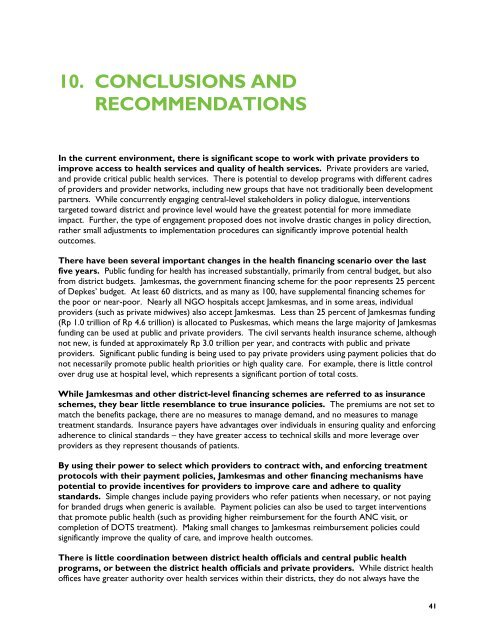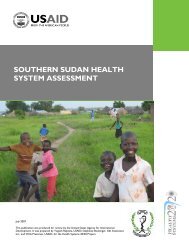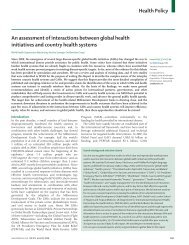PRIVATE SECTOR HEALTH CARE IN INDONESIA - Health Systems ...
PRIVATE SECTOR HEALTH CARE IN INDONESIA - Health Systems ...
PRIVATE SECTOR HEALTH CARE IN INDONESIA - Health Systems ...
- No tags were found...
You also want an ePaper? Increase the reach of your titles
YUMPU automatically turns print PDFs into web optimized ePapers that Google loves.
10. CONCLUSIONS ANDRECOMMENDATIONSIn the current environment, there is significant scope to work with private providers toimprove access to health services and quality of health services. Private providers are varied,and provide critical public health services. There is potential to develop programs with different cadresof providers and provider networks, including new groups that have not traditionally been developmentpartners. While concurrently engaging central-level stakeholders in policy dialogue, interventionstargeted toward district and province level would have the greatest potential for more immediateimpact. Further, the type of engagement proposed does not involve drastic changes in policy direction,rather small adjustments to implementation procedures can significantly improve potential healthoutcomes.There have been several important changes in the health financing scenario over the lastfive years. Public funding for health has increased substantially, primarily from central budget, but alsofrom district budgets. Jamkesmas, the government financing scheme for the poor represents 25 percentof Depkes’ budget. At least 60 districts, and as many as 100, have supplemental financing schemes forthe poor or near-poor. Nearly all NGO hospitals accept Jamkesmas, and in some areas, individualproviders (such as private midwives) also accept Jamkesmas. Less than 25 percent of Jamkesmas funding(Rp 1.0 trillion of Rp 4.6 trillion) is allocated to Puskesmas, which means the large majority of Jamkesmasfunding can be used at public and private providers. The civil servants health insurance scheme, althoughnot new, is funded at approximately Rp 3.0 trillion per year, and contracts with public and privateproviders. Significant public funding is being used to pay private providers using payment policies that donot necessarily promote public health priorities or high quality care. For example, there is little controlover drug use at hospital level, which represents a significant portion of total costs.While Jamkesmas and other district-level financing schemes are referred to as insuranceschemes, they bear little resemblance to true insurance policies. The premiums are not set tomatch the benefits package, there are no measures to manage demand, and no measures to managetreatment standards. Insurance payers have advantages over individuals in ensuring quality and enforcingadherence to clinical standards – they have greater access to technical skills and more leverage overproviders as they represent thousands of patients.By using their power to select which providers to contract with, and enforcing treatmentprotocols with their payment policies, Jamkesmas and other financing mechanisms havepotential to provide incentives for providers to improve care and adhere to qualitystandards. Simple changes include paying providers who refer patients when necessary, or not payingfor branded drugs when generic is available. Payment policies can also be used to target interventionsthat promote public health (such as providing higher reimbursement for the fourth ANC visit, orcompletion of DOTS treatment). Making small changes to Jamkesmas reimbursement policies couldsignificantly improve the quality of care, and improve health outcomes.There is little coordination between district health officials and central public healthprograms, or between the district health officials and private providers. While district healthoffices have greater authority over health services within their districts, they do not always have the41
















